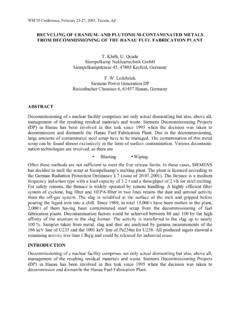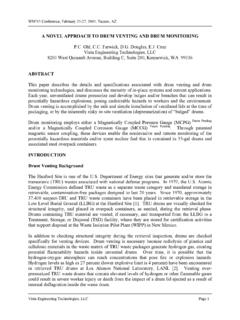Transcription of Challenges for Early Responders to a Nuclear ...
1 WM' 07 Conference, February 25 March 1, 2007, Tucson, AZ Challenges for Early Responders to a Nuclear / Radiological Terrorism Incident Wells Sacramento Metropolitan Fire District 2101 Hurley Way, Sacramento, CA 95825-3208 Stearns Shaw Environmental, Inc 2790 Mosside Blvd., Monroeville, PA 15146-2792 Davie Shaw Environmental, Inc 11560 Great Oaks Way, Alpharetta, GA 30022 E.
2 Day PELL Resources Company 11450 Huntsman Drive, Manassas, VA 20112 ABSTRACT Even in the best of circumstances, most municipalities would face severe Challenges in providing effective incident response to a large scale radiation release caused by Nuclear terrorism or accident. Compounding obvious complexities, the effectiveness of first and Early Responders to a radiological emergency may also be hampered by an insufficient distribution of radiation detection and monitoring equipment, local policies concerning triage and field decontamination of critical victims, malfunctioning communications, inadequate inter-agency agility, and the psychological fear impact on Early Responders .
3 This paper examines several issues impeding the Early response to Nuclear terrorism incidents with specific consideration given to the on-going and forward-thinking preparedness efforts currently being developed in the Sacramento, California region. Specific recommendations are provided addressing hot zone protocols, radiation detection and monitoring equipment, hasty patient packaging techniques, vertically and horizontally integrated pre-event training, mitigating psychological fear, and protocols for the effective hand-off from first Responders to subsequent Early response-recovery teams.
4 INTRODUCTION Whether from a radiological dispersion devise (RDD), improvised Nuclear device (IND), or other scenario, it is widely recognized that a Nuclear terrorism incident in an urban center is (1) not an unlikely threat, (2) not an overwhelming technical challenge for determined terrorists; (3) marginally impeded by the current barriers in accessing suitable radiological materials; (4) certain to instantly overwhelm all regional emergency response and health care surge capacities; and (5) a threat that Responders currently are only marginally prepared to meet effectively.
5 First and Early local Responders will bear the major burden of coping with a Nuclear terrorism incident response within the context of limited or uncoordinated external support until the goals of the Homeland Security Presidential Directive 8 (HSPD-8) are more fully realized. There are an estimated 10,000 radioactive sources throughout the world that exceed 1,000 curies, and of these, an estimated one thousand sources exceed 100,000 curies. To help put these numbers into perspective, an unshielded 25-gram source of Cs-137 (which looks like about cup of table salt) has approximately 2,000 curies and would provide a lethal dose of gamma radiation to anyone who remained within 1-meter of it for one hour.
6 This same mass of Cesium could be spread over as little as a city block where the dose rate would be significant for victims and Responders , or spread over several city blocks (which is a more reasonable plume estimate for an RDD achievable by terrorists) thereby rendering the dose rate nowhere close to dangerous, let alone lethal. It should be noted however that there are some large sources (exceeding 220,000 curies) used in commercial food irradiation units that would result in dangerous doses rates even if distributed over 10 square city blocks.
7 WM' 07 Conference, February 25 March 1, 2007, Tucson, AZ POTENTIAL RADIATION RESPONSE SCENARIOS Although the emphasis of this paper is towards RDD or IND radiological incidents, the emergency response to a radiation event can be anticipated in a variety of other scenarios. These include accidents and/or intentional sabotage of Nuclear facilities, intentional sabotage of storage or transportation vessels, detonation of a tactical Nuclear weapon, a Radiation Exposure Device (radiation source positioned to expose unsuspecting victims to harmful levels of radiation), improvised methods of distributing radiation (sprayers or other mechanical means), or the intentional poisoning from contaminated foods.
8 Because an RDD or IND incident is a terrorist attack, the response is substantially different than to a radiological accident. Accidents generally happen in radiation facilities where there is resident expertise and pre-planned response guidelines for specific releases of known radionuclides. Often there is a great deal of time in anticipation of the accident to activate pre-developed response Radioactive materials involved in accidents are generally well identified and the hazard is immediately known once an accident occurs.
9 Both the transportation routes and location of fixed facilities for large radioactive sources are located in areas where accidents, generally, will impact the least amount of Conversely, terrorist attacks will be intentionally committed in areas where the most impact will occur. The radionuclide or quantity will not be immediately known, and will remain unknown until Responders arrive on scene with appropriate equipment to evaluate the hazard, and protective actions will be needed immediately without notice.
10 PHASES OF RADIATION RESPONSE The DHS describes the timelines of a radiological incident in terms of three phases. The Early Phase ( , crisis or emergency phase) begins at the onset of the emergency and may have durations of hours to days. Initial protective actions are implemented by local public safety personnel including implementing the ICS, defining and securing the site perimeter, sheltering populations in place or initiating evacuations, decontamination of victims, and providing initial emergency medical treatment.




